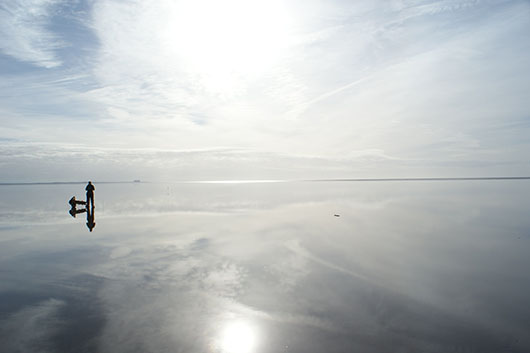Scientists return to the Essex Marshes

A team of scientists, led by the University of St Andrews, has returned to the Essex Marshes to look at how the microbes, plants and animals that live in salt marshes and mudflats contribute to our natural environment, economy and society.
The research team has been studying sites at Fingringhoe Wick Nature Reserve, Abbotts Hall Farm (both Essex Wildlife Trust sites) and Tillingham Marshes since Saturday 7 September, where they have been examining salt marshes and mudflats and the role they play in the purification of water, the production of food and the protection of coastlines, as well as the provision of habitat for wildlife and recreational space for people.
The initiative is part of a six year programme funded by the National Environment Research Council called CBESS (Coastal Biodiversity & Ecosystem Service Sustainability), a consortium made up of 14 research institutions concerned with the welfare and management of coastal systems, led by the University of St Andrews.
Professor Graham Underwood, the CBESS Site Champion for the Essex Marshes said:
“Essex contains the largest areas of salt marsh in south east England; a vital and precious piece of ‘wilderness’ close to some of our largest urban centres. The Essex estuaries are an internationally significant natural habitat, protected by national and international conservation designations and are a proposed marine conservation zone. At the same time, they are heavily used for recreation, and support important local industries such as oyster fisheries.”
Dr Anne Cotton of University of Essex added:
“As well as being one of the most beautiful and important habitats in the region, these habitats are also currently under threat. It’s been estimated that in recent years, a quarter of the Essex saltmarshes have been lost to erosion. There’s therefore never been a more important time to study them to better understand exactly what benefits we obtain from these areas, how they produce these and how they’re changing.”
The summer field campaign is the final phase of environmental data collection, what follows is the sorting, testing and analysing of over 19,000 samples collected from the salt marshes and mudflats of Essex and Morecambe Bay. This information will be shared with those interested in using and managing coastal systems and used to inform practical methods and improved tools for the future management, and sustainability of the UK’s coastal wetlands.
ENDS
Notes to Editors
Issued by the University of St Andrews Press Office.
Contact the Press Office on 01334 462530 / or email [email protected].
Professor Graham Underwood is available on +44 (0)1206 873337 and Dr Anne Cotton is available on +44 (0)1206 873370.
Or contact Meriem Kayoueche-Reeve (CBESS Project Officer) on +44 (0)1334 463613
- The study is part of a six year programme funded by NERC (National Environment Research Council) in 2011 called BESS (Biodiversity & Ecosystem Service Sustainability). BESS is made up of four research consortia which aim to understand these links in urban, coastal, lowland agricultural and upland river environments.
- CBESS (Coastal Biodiversity & Ecosystem Service Sustainability) is a consortium made up of 14 research institutions, universities and organisations that is concerned with the welfare and management of coastal systems.
Category Research